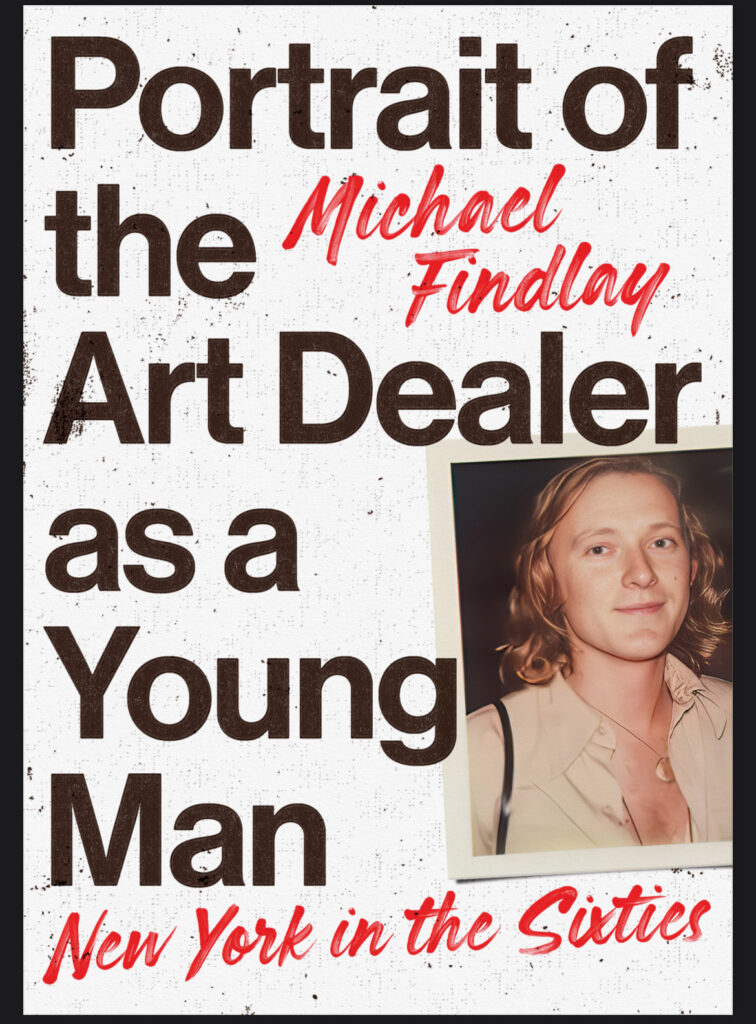“Portrait of the art dealer as a young man”
By Michael Findlay
Prestel Publishing, 288 pages
There are those among us who lead charmed lives, and then there is Michael Findlay. In his latest autobiographical account, Portrait of the Art Dealer as a Young Man, he takes readers on a rollicking journey through New York City’s fabled downtown art scene in the 1960s. In a loose, tongue-in-cheek tale of sheer luck, 1960s escapades, ingenuity, and the madness of great art, he lovingly describes the artists, dealers, and collectors who made SoHo’s loft scene a perpetual hotbed of cultural and artistic innovation.
As a young boy from Britain, Mr. Findlay had his first eye-opening encounter with Salvador Dali’s painting “Christ of Saint John of the Cross” at the Kelvingrove Museum in Glasgow. What followed was a fascination with art and literature that eventually led him, via a scholarship to York University in Toronto, into the eye of the cyclone that was the New York art world of the 1960s.
When he was barely 18, Mr. Findlay came to New York for a short visit and, like so many others, decided to stay. An aspiring poet, he tried unsuccessfully to find work in bookstores. A young friend suggested he work in an art gallery. “I thought I could sit at the reception with my Olivetti, type my poems and smile at the customers as they came in,” he says.
It was in this wonderfully naive state of mind that he walked into the Fig Gallery and landed his first art job, which would last him for over a decade and cement his position as one of New York’s top art dealers. He had stumbled upon his hobby by chance and soaked up his new boss’s wisdom on the art trade.
“Richard Feigen was an incredible speaker,” recalls Mr. Findlay. “He really had the gift of speaking. I learned that from listening to him on the phone in the office. He would say anything, true, false and in between, to sell a picture.”

At the time of Findlay’s arrival, the Feigen Gallery represented emerging British Pop artists, many of whom became close friends. The gallery also distributed an impressive second list of Impressionist and post-war artists, the sales of which funded exhibitions for emerging talent. In the meantime, Findlay was constantly learning.
It was a scene so full of talent that he just had to learn. During his first two years at Feigen, Findlay met Roy Lichtenstein, Jasper Johns, Bridget Riley, Robert Rauschenberg, John Baldessari, Hannah Wilke and Andy Warhol, to name a few. The number of art historians and influencers in his immediate circle was staggering.
Mentors were also plentiful. In addition to Feigen, Kynaston McShine, the gruff Caribbean curator and later director of the Jewish Museum, helped Mr. Findlay develop the knowledge he needed to keep his job and curate his first exhibition at 19. “I probably learned the most from him,” he says. This was eventually reflected in Mr. Findlay’s eclectic and groundbreaking exhibitions as Feigen’s director, in which he introduced the world to the enigmatic collage artist Ray Johnson, the textile artist Claire Zeisler and the Fluxus giant Joseph Beuys. The wilder, more conceptual and performative the work, the better.
There was also an extensive nightlife. With his lanky looks and fashionable British style, Mr. Findlay mingled with models and It girls and even worked as a model on the side. Max’s Kansas City, just opened by Mickey Ruskin, was the first hangout for artists and cool people.
“Before it was a rock’n’roll club upstairs, Max’s was for the art crowd,” Mr. Findlay recalls. “Ruskin was incredibly generous. Anyone who gave him art would eat and drink for free, often for years, so it was a popular meeting place.”
Mr. Findlay almost remodeled a New York landmark himself. He almost invested in a run-down tavern called The Stonewall Inn, which would later become the epicenter of the historic Stonewall riots and change LGBTQ history forever. Mr. Findlay and his friends planned to turn it into a London-style swinging club called the “At.” During negotiations, their prospective landlord calmly put a gun on the table and they lost interest. “You couldn’t open a nightspot in the Village without the Mafia showing up,” he says, laughing wryly.
Findlay stresses that dealing with art world figures and celebrities, both famous and shady, was not as glamorous as it sounds. “Of course I knew people who are very well known today, but at the time we had no idea that would be the case,” he says. “Warhol just seemed like a smart, extremely hard-working man that I was meeting with, that’s all. And there were very big names back then who are virtually unknown today.”
Findlay split from Feigen in 1972 and went into business for himself, but he remained a mainstay and social force in the New York art world. He hosted the star-studded birthday party for 35-year-old David Hockney and purchased the “wild” coyote for Joseph Beuys’ historic performance “I like America and America Likes Me.” He also married African-American supermodel Naomi Sims.
What does all this mean for Mr. Findlay as he looks back through the lens of his charming memoir? He insists that the auction-driven art world of today bears little resemblance to the world that so generously welcomed him. He also believes that the marriage of art and fashion, which was initially very exciting, has unfortunately led to a lot of money-driven emptiness.
“When I started, it was very welcoming and collegial,” he recalls. “Friendly but serious. It wasn’t glamorous or money-driven. We were in our own little world, pursuing our own interests. There were no art advisors. Everyone hung out together and big collectors would actually walk into the galleries and talk to you in person. We never used the term ‘art market.’ If someone had mentioned that phrase at a party, everyone would giggle. That’s what they call it now.”




